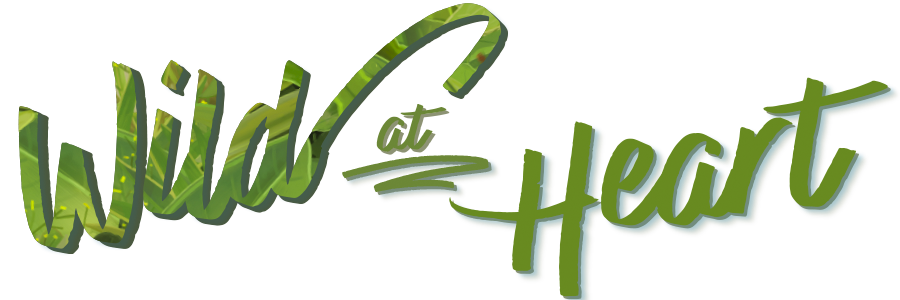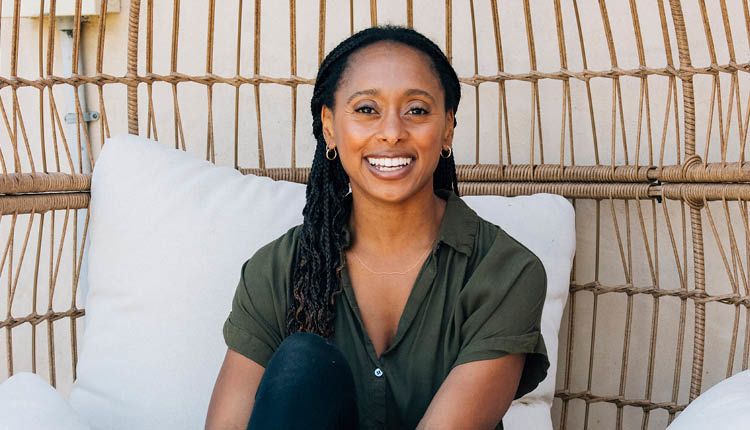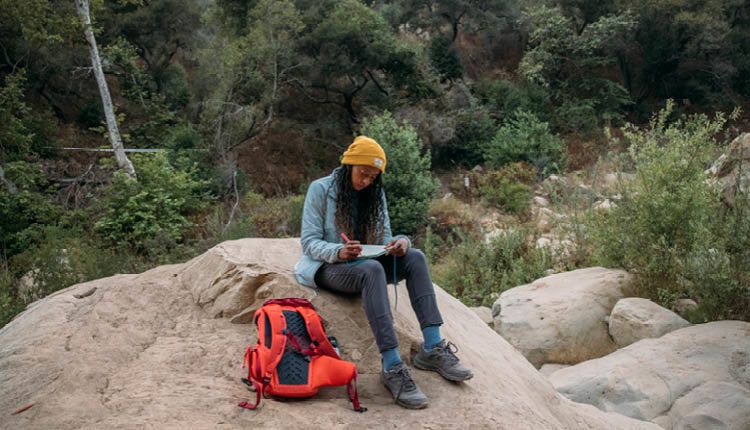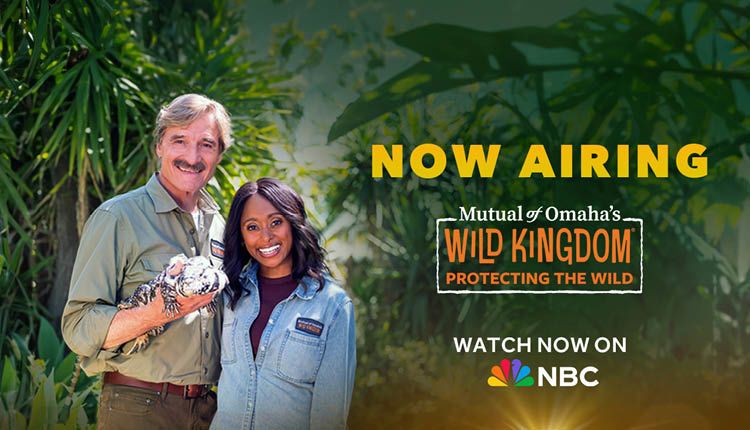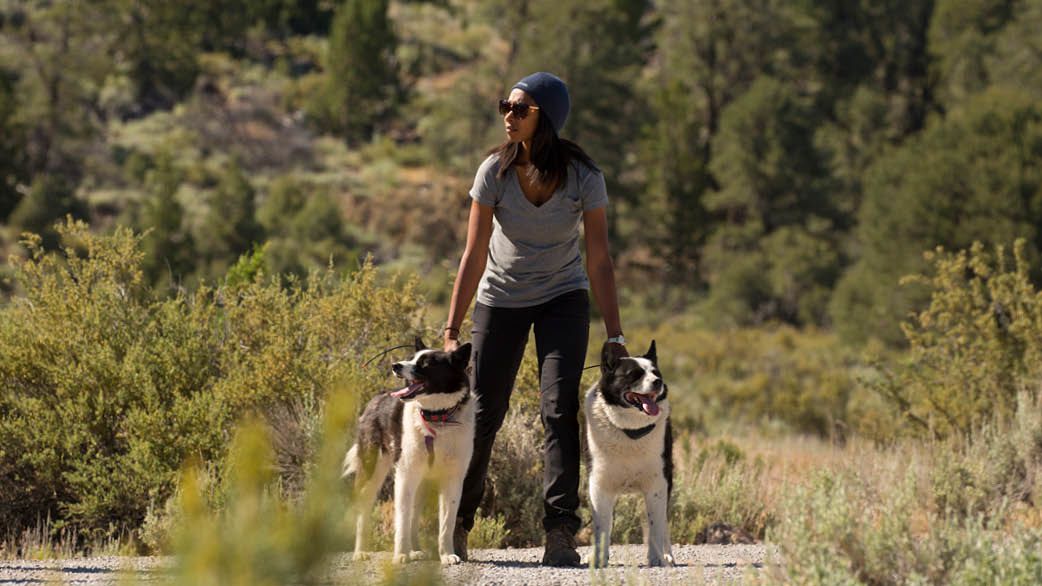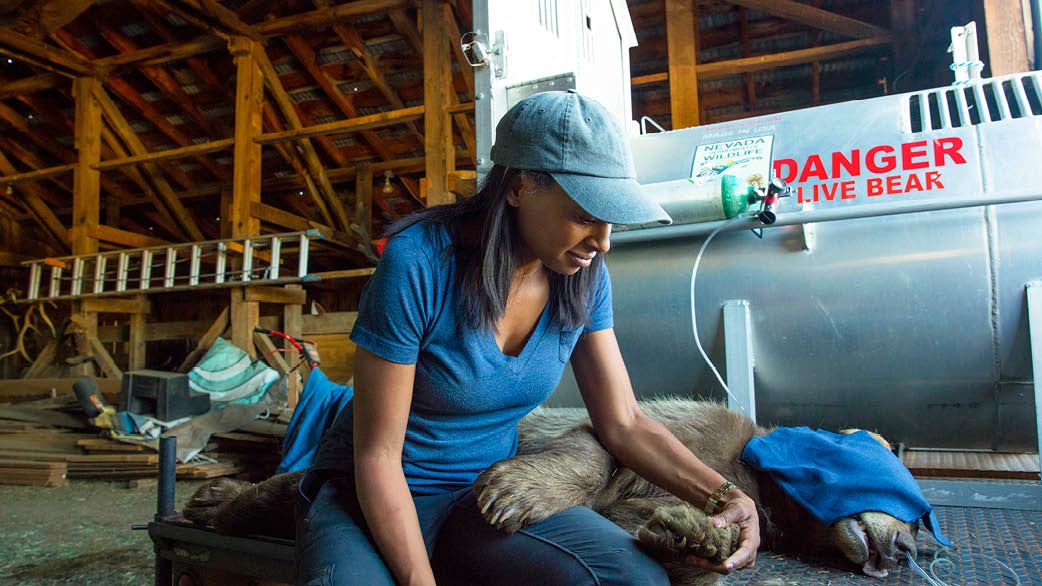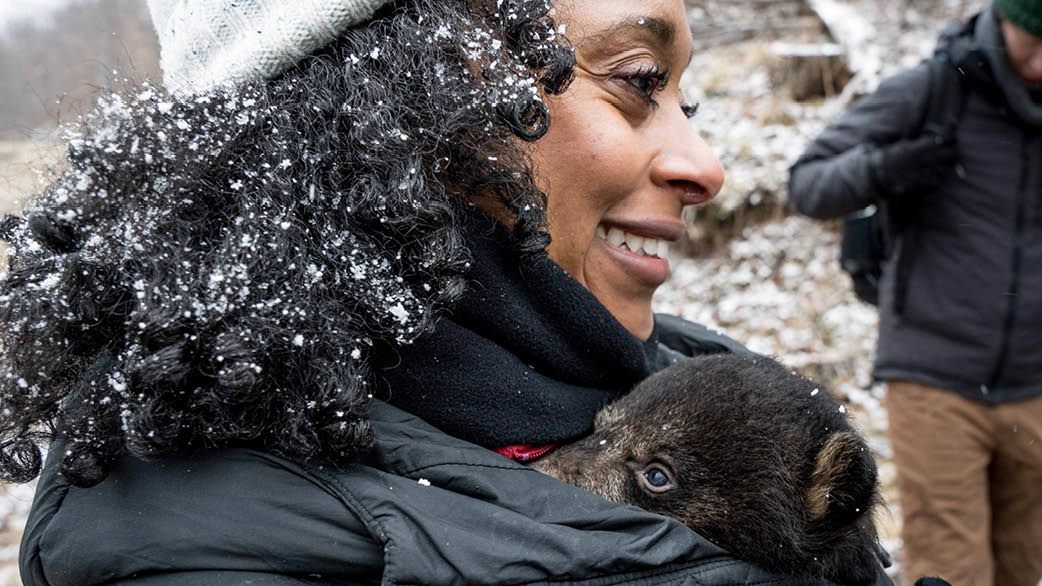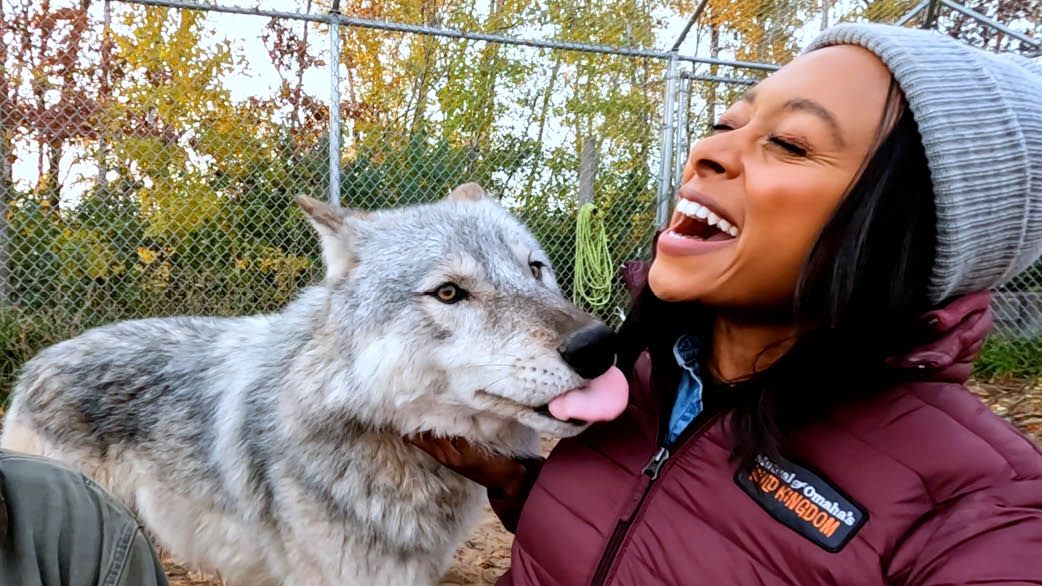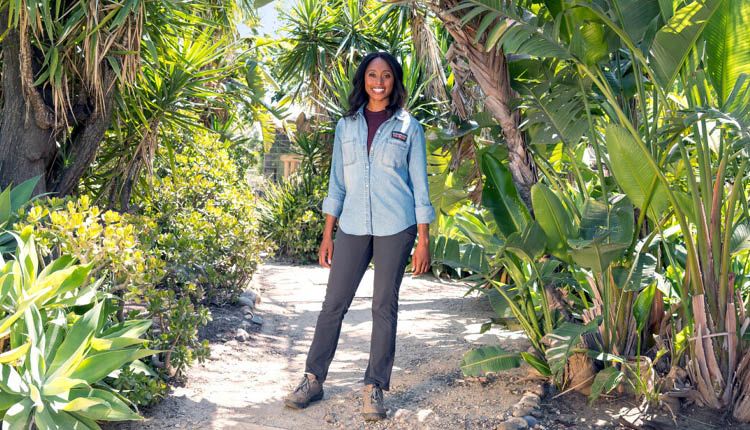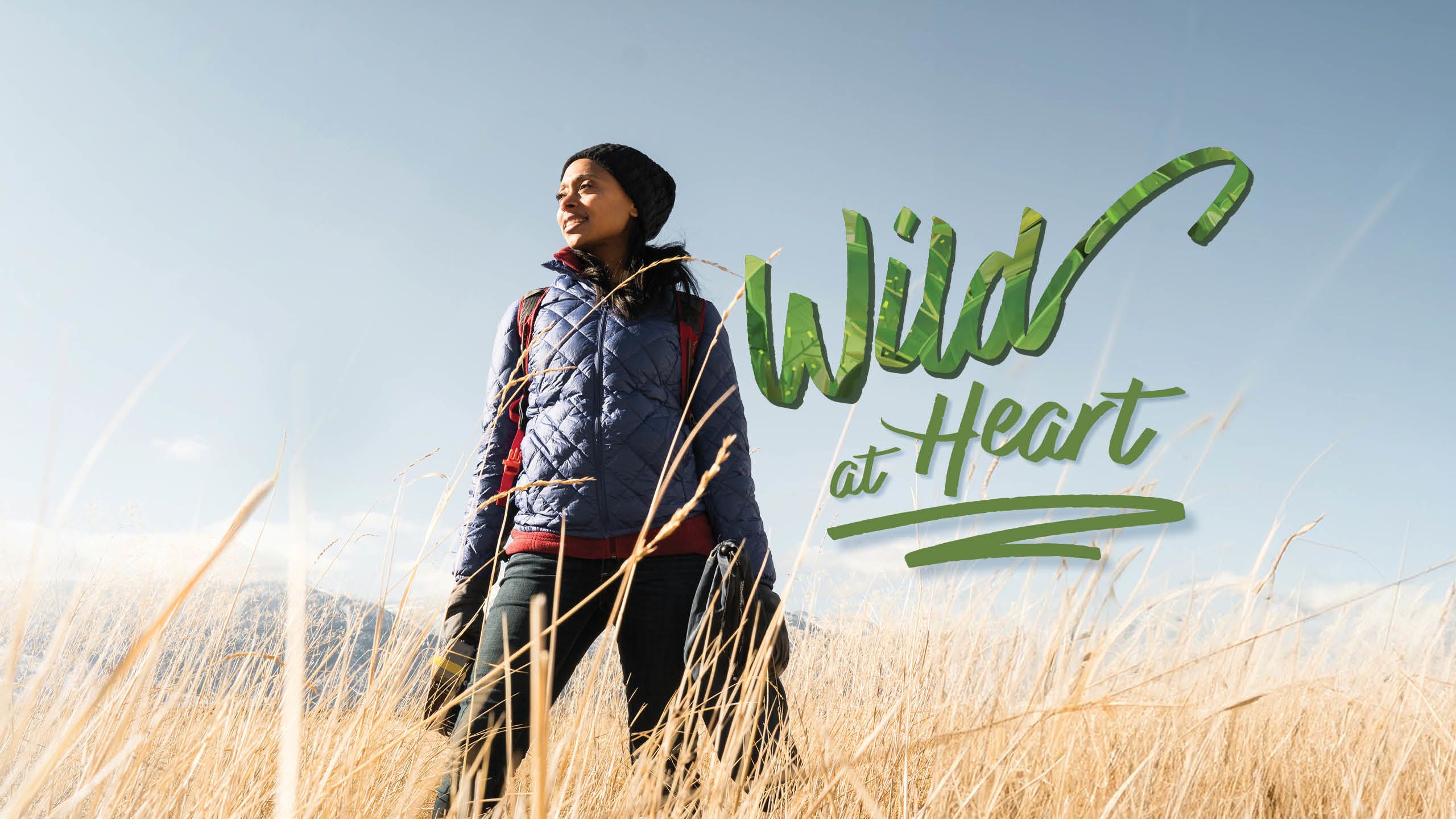
EMORY MAGAZINE | SUMMER 2024
Emory alumna Rae Wynn-Grant, co-host of the rebooted “Mutual of Omaha’s Wild Kingdom Protecting the Wild” on NBC, has blazed trails and broken barriers to achieve her childhood dream. A large-carnivore ecologist, she’s using her new platform to teach millions about how humans can coexist with lions, tigers and bears (oh my!) while inspiring future generations of scientists — as they finally see a wildlife expert who looks like them on TV.
By Roger Slavens
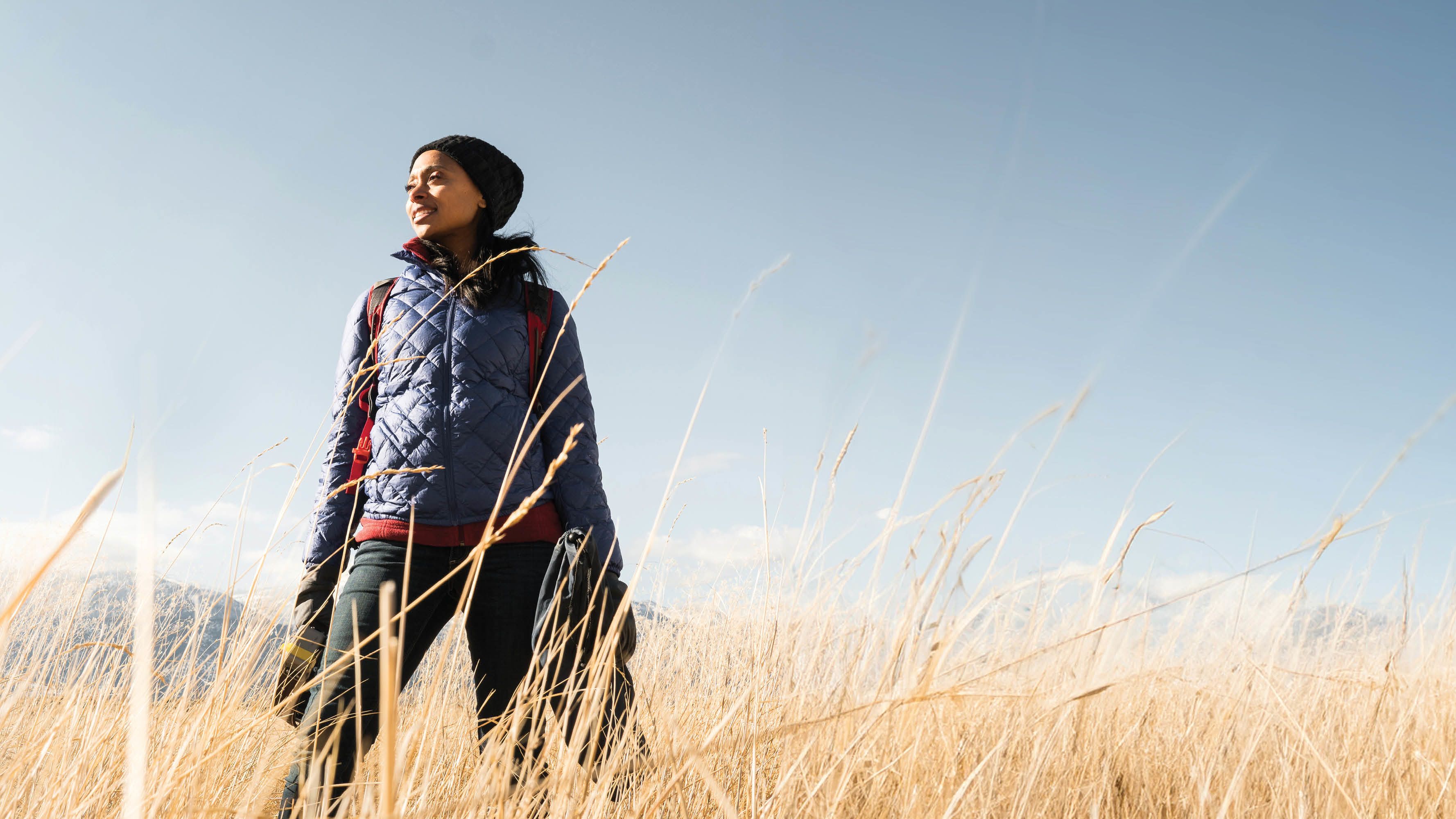
Growing up in California’s Bay Area, Rae Wynn-Grant 07C lived in one of those households where watching TV was frowned upon. Her father was an architect and a college professor; her mother, a writer. “Both placed a premium on education for me and my younger brother,” Wynn-Grant says. “They thought TV would rot our brains.”
She says she felt like she was the only kid in her friend group for whom TV was off limits. “At recess, I’d hear them talk about their favorite shows, like ‘Rugrats’ and the ‘Power Rangers,’ and I had never seen them,” she says. “I felt out of touch.”
Rae Wynn-Grant is a large carnivore ecologist and the co-host of "Mutual of Omaha's Wild Kingdom Protecting the Wild."
Rae Wynn-Grant is a large carnivore ecologist and the co-host of "Mutual of Omaha's Wild Kingdom Protecting the Wild."
Her family did own a TV, but it only came out of the cabinet for NBA games. Her father was a huge fan of the local Golden State Warriors and the Michael Jordan-led Chicago Bulls. “We were allowed to watch basketball with my dad, but we had to leave the room during commercial breaks,” Wynn-Grant remembers.
As she and her brother grew older, they begged their parents for permission to watch some TV until they finally relented. But there was one condition: they could only watch educational programming, such as shows on PBS and Animal Planet.
It was better than nothing — far better. In fact, Wynn-Grant soon found herself infatuated with animal and nature shows, the ones hosted by Steve Irwin, David Attenborough and Marlin Perkins. “These hosts showed me a completely different part of the world that I had never seen,” she recalls, “and I immediately fell in love with all the fauna and flora across far-flung locales on the globe.”
One night at the dinner table — when she was around seven years old — she announced that when she grew up, she was going to host a nature show of her own. “I was going to live in the jungle and tell people about all the animals,” Wynn-Grant writes in her recently published memoir, “Wild Life: Finding My Purpose in an Untamed World.”
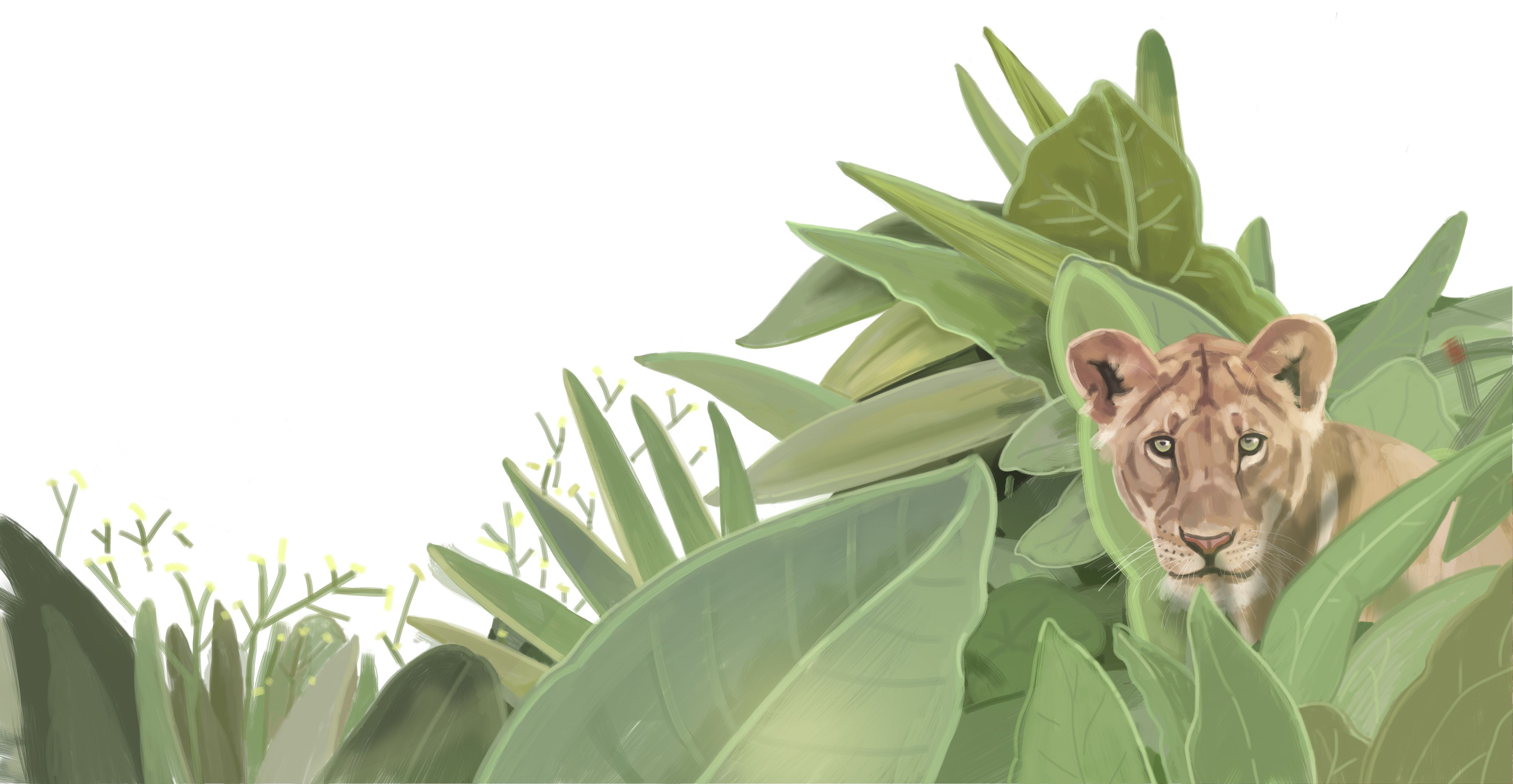
Starting Her Life's Journey
She doubled down on that declaration in 2003, some 10 years later, during preorientation at Emory. She chose the university for its expertise in the sciences and its proximity to Atlanta, which she calls “the Black mecca of the South.” In that preorientation session, she was encouraged to write down the dream she most desired and, from there, to sketch out a five-year plan to achieve it.
At the urging of a student mentor, who jotted down the simple-yet-momentous prompt “Rae’s Life” for her at the top of a yellow legal pad, Wynn-Grant followed up by listing her singular goal: “Host a nature show.” She then created a rough timeline that included classes she needed to take — environmental sciences seemed to be the best major — as well as the first job she thought she’d have after graduating from Emory and any other degrees she’d need along the way.
“It’s what I wanted most in the world,” Wynn-Grant says. “But deep down, I didn’t know if it was possible.”
While her heart was set on fulfilling her dream, her mind kept ticking off some serious doubts. For one, she hadn’t fared particularly well in her STEM classes in high school. Doing well in math and biology seemed important to studying ecology, she surmised.
Second, she’d spent very little time in or around nature through her first 17 years. Virtually all her exposure to wildlife had come through TV and textbooks. “We’d never gone camping, and I had zero experience with hiking, pitching a tent, cooking over a fire or anything else that could be remotely construed as roughing it,” Wynn-Grant writes in her memoir.
Her biggest doubt came from the stark fact that she had never seen someone like herself — Black or female — host a major nature TV program. “Don’t get me wrong, I loved Steve, David, Marlin and the other hosts, but all of them were scruffy, roguish white men, most of them British or Australian,” she says. “There was no one at the time doing this job who looked or sounded like me.”
Of all the obstacles she’d face in pursuing her dream of being a TV nature show host, this would be the one that she’d struggle repeatedly to overcome.
Nevertheless, she persisted. And prevailed. A little less than 20 years after graduating with a bachelor’s degree in environmental science from Emory, followed by two master’s degrees, a doctorate and numerous years working as a large-carnivore ecologist and researcher, Wynn-Grant made her dream come true.
"Wild Kingdom Protecting the Wild" has been such a success, it's already been picked up for a second season.
"Wild Kingdom Protecting the Wild" has been such a success, it's already been picked up for a second season.
In 2023, she debuted as the co-host of “Mutual of Omaha’s Wild Kingdom Protecting the Wild,” an NBC reboot of the long-running nature show originally hosted by one of her idols, Marlin Perkins. In doing so, she not only reached her long-held dream, but blazed new trails as the first Black woman ever to host a major wildlife program. This new version of “Wild Kingdom” has been so successful — with an average of more than 1.1 million weekly viewers, it ranks as the most-watched weekend wildlife show across broadcast and cable television in the U.S. — that it was renewed for a second season before the first ended.
But the journey to get this moment wasn’t easy. In fact, she almost completely gave up on her dream.

Finding Her Way at Emory
Wynn-Grant thrived at Emory despite what she perceived as poor STEM skills. It turned out that, up until now, she simply hadn’t been taught the right way. A host of supportive and kind faculty members helped her regain confidence.
“I was scared that I was going to fail my first math class, so I did something unusual for me — I asked for help,” she says. “My professor was so patient and so accommodating in helping me to better understand everything that I had learned wrong.”
She didn’t earn an A, but she passed the class. “It gave me a lot of confidence and taught me that success wasn’t something that had to be achieved alone,” she says. “At Emory, I finally realized that working collaboratively with peers, teachers and tutors was a legitimate way of mastering the material.”
After two years of courses, including a number of classes in environmental science, Wynn-Grant realized her lack of firsthand knowledge about nature was holding her back from connecting all the dots through her classroom and textbook learning. “So I signed up for the most intense study abroad program I could find that also fit within my financial aid package,” Wynn-Grant says.
She spent a semester in Kenya and while on the African continent quickly found what she was missing — experiences living in the bush, interacting up close with wild animals like lions and elephants, conducting real fieldwork — and learned a lot about herself in the process. (See “Getting into Nature.”)
“The experience was thrilling, it was educational, it was immersive and it absolutely reaffirmed that I was on the right path toward a career in environmental science and ecology and eventually hosting a nature TV show,” she says.
After graduating from Emory in 2006, Wynn-Grant landed her first job at the World Wildlife Fund (WWF) — albeit as an administrative assistant. “I thought this was OK because I was getting my foot in the door with an organization I admired so much,” she says. “I was going to be surrounded by scientists, my real-life heroes working to make the world a better place.”
But while she loved the WWF, she hated her job. “It was a job anyone could have done, and it wasn’t a good use of my efforts or my education,” she says. “I wanted to work on solving environmental problems and instead I was making coffee and filing receipts.”
Years later, she would return to the WWF to give a speech during a Black History event. “I told them that no one really looked at me as a future scientist, even with my degree from a top university and all the initiative and interest I showed. No one took the time to talk to me about my goals. No one took me under their wing. And I firmly believe it was because I was Black.”
The WWF not only took her words to heart, but also invited her to take a seat on their National Council. “Because I come from a historically repressed identity group, today I use my experiences to enlighten organizations like the WWF about the barriers to entry into the environmental movement for young Black scientists and work with them to be more inclusive with all groups,” she says.
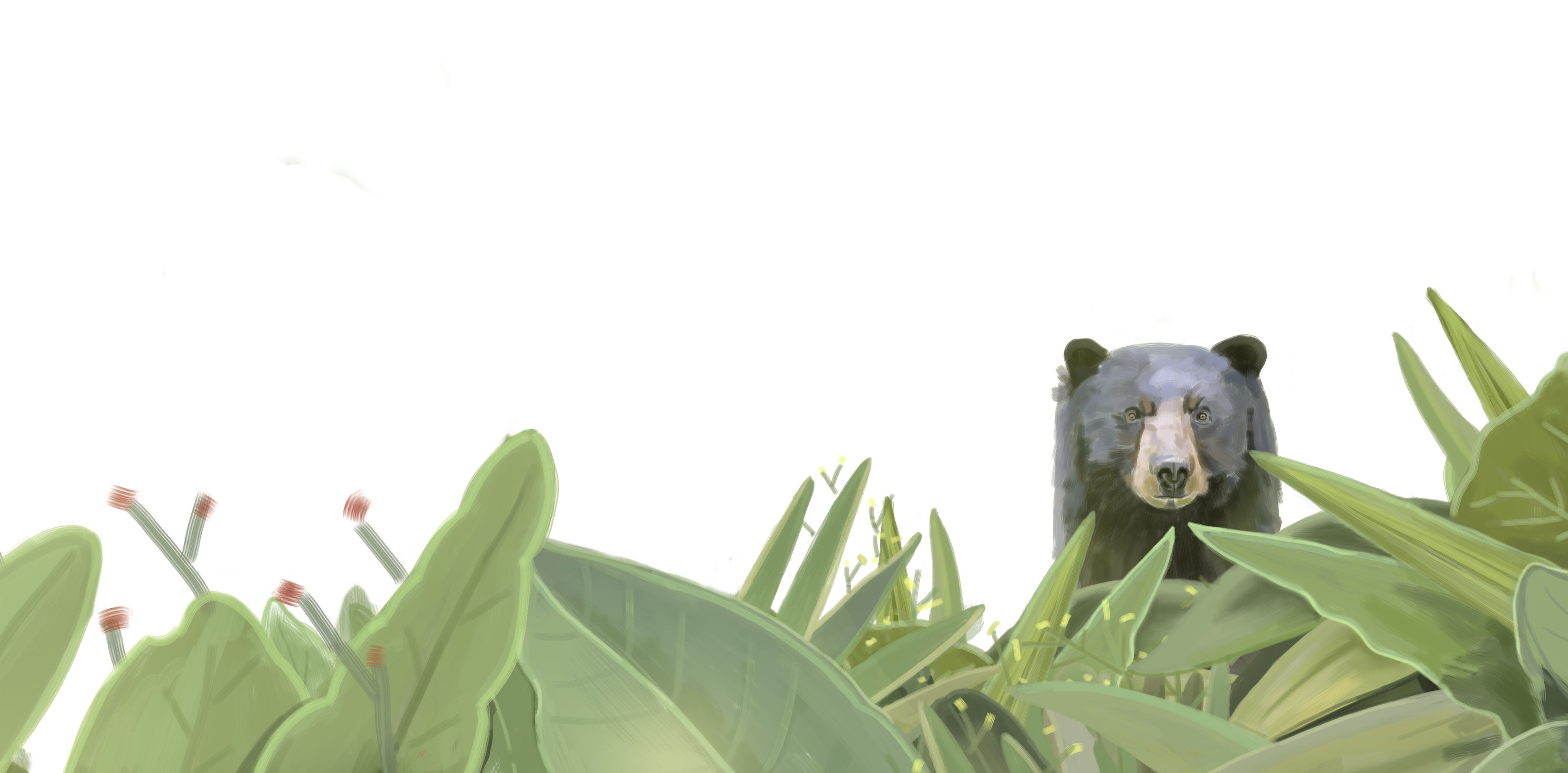
Putting Herself Back on the Right Path
During her frustrating year languishing as a WWF administrative staffer, Wynn-Grant started applying to graduate schools. She got into a master’s program, complete with full scholarship, at the Yale School of the Environment, where she knew she could refocus her energies directly on wildlife conservation.
“When I got to Yale, my advisor asked me what I wanted to study,” she says. “I didn’t know I could choose.”
It took only a matter of seconds for her to pick: She wanted to study lions in Africa. “As a kid watching nature shows, I always got excited when they featured big, dangerous, ferocious, charismatic megafauna like sharks, tigers and bears,” she adds. “I had interacted with lions during my study abroad in Kenya and I was fascinated by them. They were the largest and scariest carnivores I had ever seen.”
In her memoir, Wynn-Grant mentions a frightening encounter during that first stint in Kenya when she sensed a lioness prowling outside her tent late at night.
“After I had somewhat recovered from the experience, I got curious,” she writes. “Why didn’t the lioness attack me? There was a thin piece of material separating me from her. It would’ve been easy enough for her to claw her way into the tent. I’d soon learn that, unlike bears — which will do anything to get at food, including tearing open a tent and attacking a human — most big cats don’t waste their energy attacking things they can’t see.”
The encounter solidified her interest in lions and her adviser at Yale didn’t bat an eye at her request to study them.
The highlight of her master’s studies was a semester spent in East Africa, learning from her new mentor, Laly Lichtenfield, a National Geographic Explorer and big-cat conservationist. She spent a summer researching lions up close, learning to track them, observing the dynamics of their familial prides and finding out firsthand the challenges of trying to save their numbers as they and humans tried to coexist. She witnessed the aftermath of lion attacks on a Masai community, as well as the impacts of wildlife poaching on both people and animals, and grew to understand the delicate, uneasy balance.
Wynn-Grant followed up her master’s in wildlife conservation at Yale with doctoral studies in ecology and evolution at Columbia University. “My focus shifted at Columbia, where they were more focused on ecology rather than conservation,” she says. “Instead of studying lions — animals on the Endangered List — and trying to save them, they wanted me to study another large carnivore that was faring better in the wild, specifically bears in North America.”
Wynn-Grant started studying bears while she was earning her PhD.
Wynn-Grant started studying bears while she was earning her PhD.
At first, she was reluctant to make the switch to bears. “But studying them changed my life for the better,” she says. “I can’t imagine my life without my work with bears.”
At Columbia, Wynn-Grant started researching bears before she’d ever seen one in the wild. “The only animals I had interacted with up to this point were all in Africa,” she says. After two semesters of studying them from afar, she flew out to Western Nevada in summer 2011 and saw her first black bear in person, falling in love with the furry and lovable yet dangerous creatures.
She’s been studying bears ever since. “My [early] research focused on how bears reacted to environmental challenges such as forest fires, drought and highways being built in the middle of their habitat,” she writes in her memoir.
“The conclusions I was making about bear ecology and the types of landscape changes humans bring about would be crucial to other conservation projects all over the world, in places where human development continues to encroach upon the natural habitats of wildlife. Our work was meant to protect these animals, to protect their habitats and facilitate the balancing of what was becoming an unequally yoked ecosystem.”
Since those early days of field research, she’s gone on to study jaguars in Panama, lemurs in Madagascar, grizzly bears in Montana and more during the past decade. She collaborated with a wide array of leading researchers and organizations in the process, giving her an incredible swath of experiences as a wildlife ecologist and an ever-growing list of enviable research opportunities.
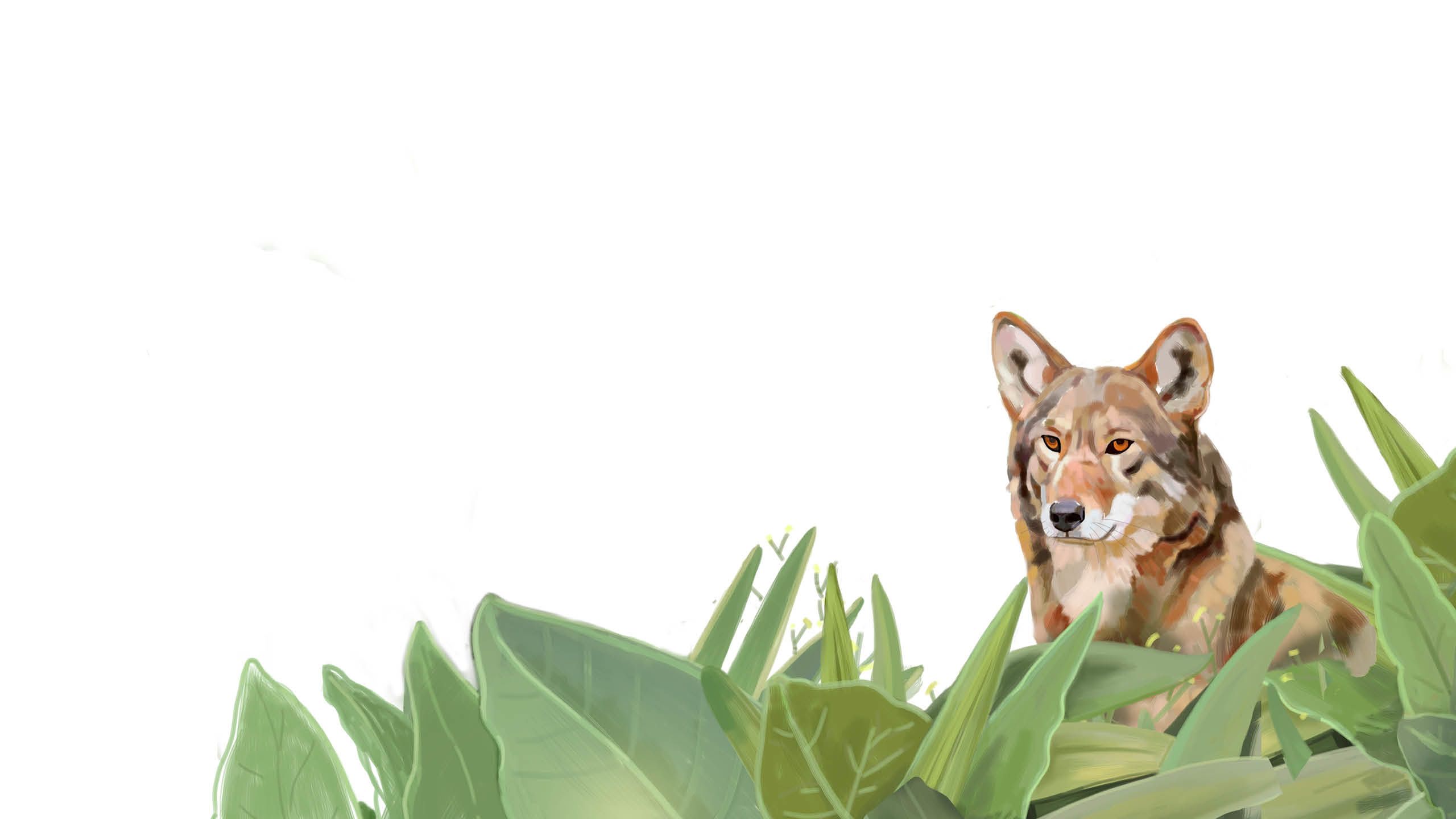
Making the Most of Her Opportunities
Today, Wynn-Grant wears many hats as a wildlife ecologist and a renowned expert on large carnivores.
She serves as a researcher at the Bren School of Environmental Science and Management at the University of California-Santa Barbara. “I don’t teach, but I work with graduate students on my research on a population of mountain lions that live on a nature preserve about an hour north of Santa Barbara,” she says.
The Jack and Laura Dangermond Preserve “is a really special place,” she says. “It has so many different ecosystems. There’s hills, there’s oak trees and woodland forest, there’s scrub brush, there’s sand dunes, there’s coastline, and the ocean itself is actually a marine protected area.”
Wynn-Grant says there’s never been a long-term research project on carnivores like mountain lions in such a unique landscape.
“We don't have a lot of data about how they move and how they behave and what they eat and what they need,” she says. “But they seem to behave in a really distinct way because their habitat is protected and the coastline is protected there, too. For example, it’s possible and probable that large carnivores are using the ocean for food.”
Part of her research funding comes from the National Geographic Society. “Nat Geo is a lot of things, including a media company with magazines and TV shows,” Wynn-Grant says, “but most people don’t realize it’s also a scientific funding organization. It has funded my academic work for the past five-plus years.”
As a research fellow for National Geographic, she has also been featured on a number of its TV nature programs — though none as an official host — and recently finished up on a 20-city speaking tour nationwide at Nat Geo Live events.
She is a visiting fellow at the American Museum of Science and History in New York City, where she had previously worked as a staff ecologist. In addition to having a seat on the WWF’s National Council, she serves as an advisor and collaborator with a number of other conservation-minded organizations and corporations, including The North Face’s Explore Fund Council.
“One of my main roles is to push these organizations on diversity, equity, inclusion and justice initiatives,” she says, “and to create opportunities for future generations of scientists who don’t fit the antiquated mold.”
During this period of rapid professional growth, she’s taken the time to sharpen her communication skills and build a healthy media presence. Pairing her expansive scientific knowledge with an upbeat, relatable, easygoing personality, Wynn-Grant has been in demand for interviews with the likes of Vogue, Forbes and the New York Times.
In 2021, during the pandemic, PBS approached her to host a novel nature podcast. “The original idea centered on the fact everyone was locked up at home and can’t travel to see nature, but maybe we can take the audience on virtual nature walks through their ears and imaginations,” she says. “Those first early episodes — where I’d recreate, say, a trip through a rainforest, complete with ambient sounds — were kind of like guided meditations.”
Since then, the podcast — called PBS Nature’s “Going Wild with Dr. Rae Wynn-Grant” — grew in popularity and evolved into a showcase for sharing some of her wildest experiences out in the field. “From there, I then started bringing in guests who were also Black and Brown wildlife ecologists and I’d have them tell their own wildlife stories from all over the world,” she says. “Each story became not just the adventure and the suspense of working with a wild animal, but also a parallel narrative about identity and the journey that goes along with it.”
Wynn-Grant is very proud of her podcast, which finished its third season last year and has won numerous awards. But it still wasn’t that nature TV show upon which she had long set her heart.
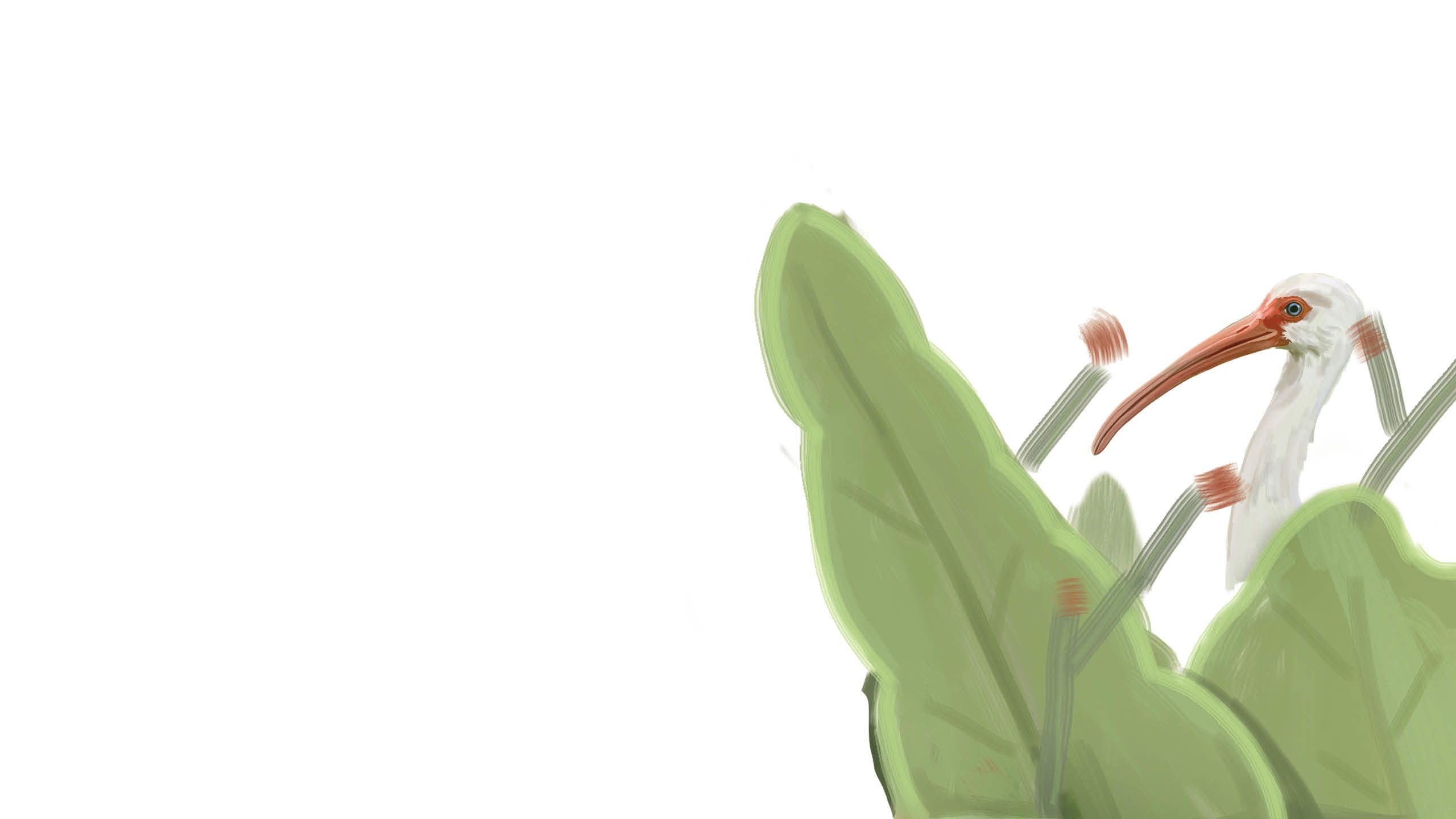
Fulfilling a Dream (That Almost Didn't Come True)
“During the past six or so years of my life — when everything was going so great for me as an academic researcher and I started getting national media attention — unfortunately I was also experiencing rejection after rejection when it came to the prospect of hosting my own nature show,” Wynn-Grant says.
“After earning my advanced degrees, after living and performing research all around the world, after becoming a respected thought leader in the field, after hosting a major podcast and all the rest, it still wasn’t enough,” she notes.
Because she was Black. Because she was a woman.
“I had a network executive tell me that even though he thought I was the real deal — both from my expertise as a scientist and as a media presenter — that it wouldn’t happen for me because no one like me had ever done it before,” she says.
Following numerous attempts across nearly two decades of professional growth, she put her childhood dream away. “It was really becoming harmful to my mental health to keep pushing because of all the doors I had shut in my face,” Wynn-Grant says.
She instead focused on the good things in her life: her research and the graduate students she worked with, her public speaking and media opportunities, her successful podcast and the book she was starting to write and, of course, all the time she got to spend in nature.
She then received an email out of the blue: Would she be interested in co-hosting a revival of an old nature show?
And it wasn’t just any nature show, it was “Mutual of Omaha’s Wild Kingdom,” the forerunner of them all that debuted back in 1963. The producers trying to get the reboot off the ground wanted someone with a strong science background. They wanted a new, different voice and face. They wanted her.
“I didn’t push for this,” Wynn-Grant says. “I didn’t apply, I didn’t audition. In no way did I directly position myself to be visible for this opportunity. As a scientist, I question whether manifestation is real, but it’s a pretty incredible coincidence — I visualized this dream 30 years ago and it finally came true when I had all but let go of it.”
For her, it was a surreal experience but also an incredible honor. “I can’t tell you how special it is for me to be hosting a show that inspired me as a little girl, but also what a tremendous responsibility it is for me to be the first Black person, let alone a Black woman, to host a network wildlife show,” Wynn-Grant says.
In its first season, which started airing in fall 2023, “Mutual of Omaha’s Wild Kingdom Protecting the Wild” took Wynn-Grant and veteran co-host Peter Gros — a wildlife expert who has been affiliated with the show since 1985 — across the globe to encounter wildlife ranging from Great White Sharks to prairie chickens. They filmed 22 episodes and have already begun filming the second season. The program has received four daytime Emmy nominations, to boot. (Episodes are available to stream on Peacock.)
“It’s been everything I had hoped it to be,” she says. “I can’t wait to do more.”
What’s more important than the audience numbers and the nominations has been the direct feedback she’s received from viewers.
“I get a lot of positive notes from parents and teachers, especially those from Black and Brown and Latino and South Asian backgrounds,” Wynn-Grant says. “They write to me to share how much they loved nature shows when they were young but didn’t pursue careers in wildlife or environmental fields because they didn’t think it was possible for them. But for their kids, at least, I’ve proved it was possible.”
She remembers a Valentine’s Day card she received from a child who had drawn a picture of her with a bear and told her how she was their most favorite person in the world.
“If I can help make one kid feel welcomed to pursue a dream they used to feel was impossible to reach, because of our shared skin color or our shared gender, then that’s about as much as I can hope for,” she says.
With the environment and climate in so much trouble today, Wynn-Grant adds, it’s vital for there to be a greater diversity of peoples, perspectives and ideas to tackle these problems. “It’s not just the right thing to do for the sake of inclusivity, but it will ultimately result in a wider range of potential solutions and likely generate them more quickly,” she says.
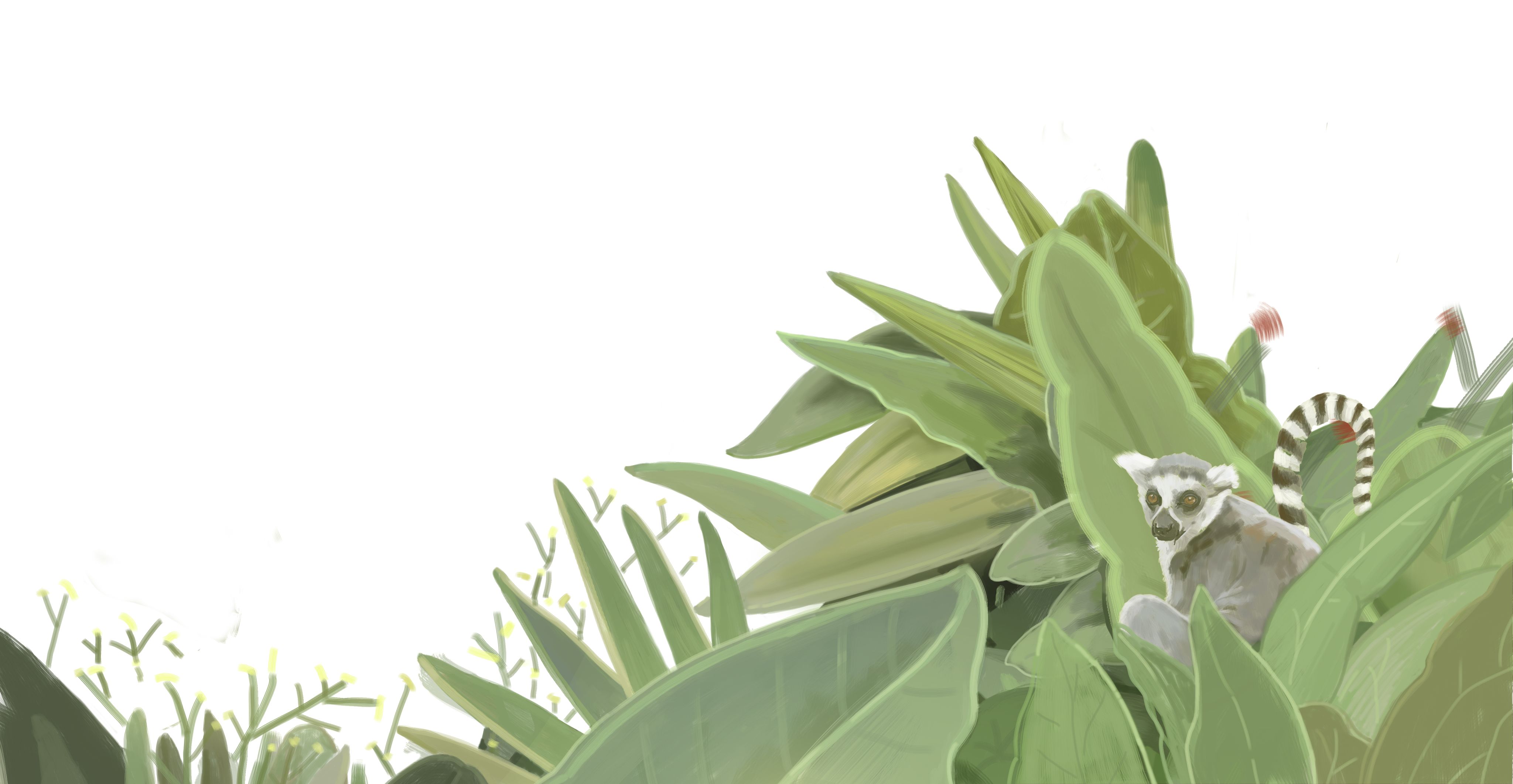
Reflecting on Her ‘Wild Life’
Wynn-Grant’s new memoir contains two parallel narratives about her life. A major part of the book involves stories about the “call of the wild” and her adventures as an ecologist, interacting with a menagerie of animals in Asia, Africa and South America.
The second involves intertwining her personal journeys of identity and womanhood, the mistakes she’s made in her relationships, the balancing of her work with motherhood and her struggles with self-confidence.
“There have been a lot of traumatic moments in my life — death, divorces and breakups, bad choices,” she says.
“Whatever life can throw at me, I feel that I can rebound and grow mentally, spiritually and emotionally when I’m off on my next adventure in the wilderness. Nature, for me, is the best medicine for my body and soul.”

An excerpt from Rae Wynn-Grant’s
“Wild Life: Finding My Purpose in an Untamed World”
As a student at Emory, Rae Wynn-Grant 07C realized that what was missing from her journey to becoming a wildlife ecologist — and, eventually, a TV show host — were real-life, up-close experiences with nature. Through Emory, she found a study abroad program in Kenya that fit the bill and forever changed her path. The following excerpt from “Wild Life” captures a few transcendent moments during Wynn-Grant’s first immersion into nature.
Early in the semester, I was recovering from a devastating E.coli infection that had completely wiped me out for a couple of days, and the high fever had made me delirious. Thankfully, I’d been prescribed some antibiotics and was soon on the mend — just in time for the class to complete the first activity on our syllabus: a hike into the Chyulu Hills, which would grant us an unparalleled view of the Great Rift Valley. This geographic feature inspired the scene in “The Lion King” where Rafiki the monkey holds up Simba, the future king, to be honored by the other animals.
Even though I’d never been hiking before, I wasn’t nervous. I figured that I had all the gear — brand-new hiking boots, backpack, binoculars, water bottles — so I was prepared. Plus, it wasn’t like we’d be climbing any mountains. At most, the incline we arrived at after an hour-and-a-half drive could be described as a hill. It had a trail that spiraled around and around, all the way to the top, which we could see from where we stood at the base.
Oh, this won’t be too bad, I thought. We began our ascent in a single-file line, and I snagged a spot in the middle of the pack.
About 10 minutes into the hike, I’d already dropped back to the end of the line because I had to keep taking breaks. I would’ve thought my asthma would do me in, or maybe even blisters from my hiking boots that hadn’t been broken in yet. But it was my burning thigh muscles that forced my slower pace. It was a painful reminder that I never exercised. My asthma had gotten me excused from gym class during my public-school years, and as a typical college student, physical fitness wasn’t a priority for me.
Imposter syndrome made me want to give up. I wanted someone else to see my struggle and tell me I didn’t have to keep going. I almost wanted my asthma to kick in so I had a legitimate excuse to stop.
But something in me knew that if I gave up now, I would keep giving up. And my dreams of becoming an ecologist and a nature host would never come to fruition.
It took me 30 minutes longer than everyone else to reach the top of the hill, and I hated every step. I had to continually give myself pep talks along the way. By the time I reached the top, I felt a mixture of triumph and humiliation.
From the top of the Chyulu Hills, we gazed across the vast Great Rift Valley, a place biologists note as the location of early human evolution. Our professors didn’t rush us, and we stayed for over an hour. I understood why they’d brought us there so early in the program. The location not only gave us an incredible view of East African landscapes but also rooted us in time and place and purpose.
If my early human ancestors could evolve in Kenya, then so could I.
On the descent, I gave myself the credit that I’d denied myself just hours beforehand. This was a big deal for me. I’d pushed myself and did something physically rigorous for the first time. Something that people in my family didn’t do.
For my entire life, I’d felt that I didn’t have a place in nature, in the wilderness, that it was unavailable to me. I didn’t see people who looked like me — whether a Black person, a woman, or a Black woman — represented as being stewards of the environment, being confident in and down and dirty with nature. The hiking experience was new and satisfying and made me feel proud of what I’d accomplished, and excited for what I could do in the future. Every step I’d taken up the hill that day was me taking one step closer to becoming the person I am today.
The day after that first hike, our professors took us on our first game drive. Our camp was in close proximity to one of Kenya’s most notable parks, Amboseli National Park, which was well-known for its large elephant population. Although we were headed to a national park, we weren’t going as tourists. We piled into four Land Cruisers, armed with our cameras, as well as clipboards, notebooks and an assignment to practice estimating distance and number of animals. Our professors said that by the end of the program, we should be able to eye a group of herbivores and jot down how many were present and at what distance from us — for example, 30 wildebeests one hundred meters away. Developing these skills would help us with the data collection we’d eventually do for our independent research projects midway through the semester.
We drove away from camp and down the dirt road that snaked through the Maasai village, called Kimana, that neighbored our camp. The drive was about 40 minutes, and I peered out of the vehicle’s dusty windows, watching the landscape turn from campsite to village to bush. Soon, not a shred of evidence of human life was within sight, and acacia trees dotted the landscape.
“The majority of wild animals live outside of national parks,” one of our professors, Dr. Moses Okello, reminded us from the front seat. “You’ll begin to see animals before we enter the park.”
His timing was impeccable. As we rounded a turn, my classmate sitting next to me gasped.
“Elephants!” she yelled.
I stood up to get a better view, and that’s when I saw them: a herd of elephants, about eight or 10 of them, eating from an acacia tree. I couldn’t believe how enormous they were.
“We will stop for more animals once we’re within the park,” said Dr. Okello. “If we stop for everything now, we’ll never reach Amboseli!” He beamed with satisfaction, and I doubt he ever tired of this moment: the awe and wonder-filled eyes of green American students having their first sighting of iconic African wildlife.
During that afternoon at Amboseli National Park, I finally saw a lion. First, a lone male with a dark-brown mane. It was lying down, camouflaged in the tall tan grasses. Our driver, Maraka, an expert animal spotter, saw him first. He stopped the truck on the dirt road and instructed us to grab our binoculars. I pulled mine out and focused them where he was pointing. If it weren’t for the lion’s tail flicking every few seconds, I wouldn’t have spotted him. When he came into focus, I gasped.
The lion must have been a good-luck charm, because the next hour was filled with numerous animal spottings: giraffes, zebras, wildebeests, gazelles, hippos, fish eagles, cheetahs and more elephants. Some were active and excitable, like the antelopes that bounded away from us as our truck approached. Others were unbothered and conserving their energy, like the pride of female lions that barely glanced at us while they dozed in the afternoon sun.
My intention when I applied for the program was becoming a reality — I was living the life of a wildlife television host, sans cameras. But it was more than that. I was learning the ecology, the fullness of the landscape, and the details of the conservation issues, in real time and from the most authentic people. Our professors had been born in this place, then gone off to Europe and the United States to receive degrees. After graduation, they’d returned to advance wildlife conservation in their home country, while training the next generation of conservationists.
Being a nature-show host would always be one of my goals, but becoming a conservation scientist and ecologist — someone who worked to find ways to keep these wild animals, landscapes, and ecosystems thriving — was of even greater importance.
“Wild Life: Finding My Purpose in an Untamed World,” published in April 2024 by Zando/Get Lifted Books, is available at bookstores everywhere.
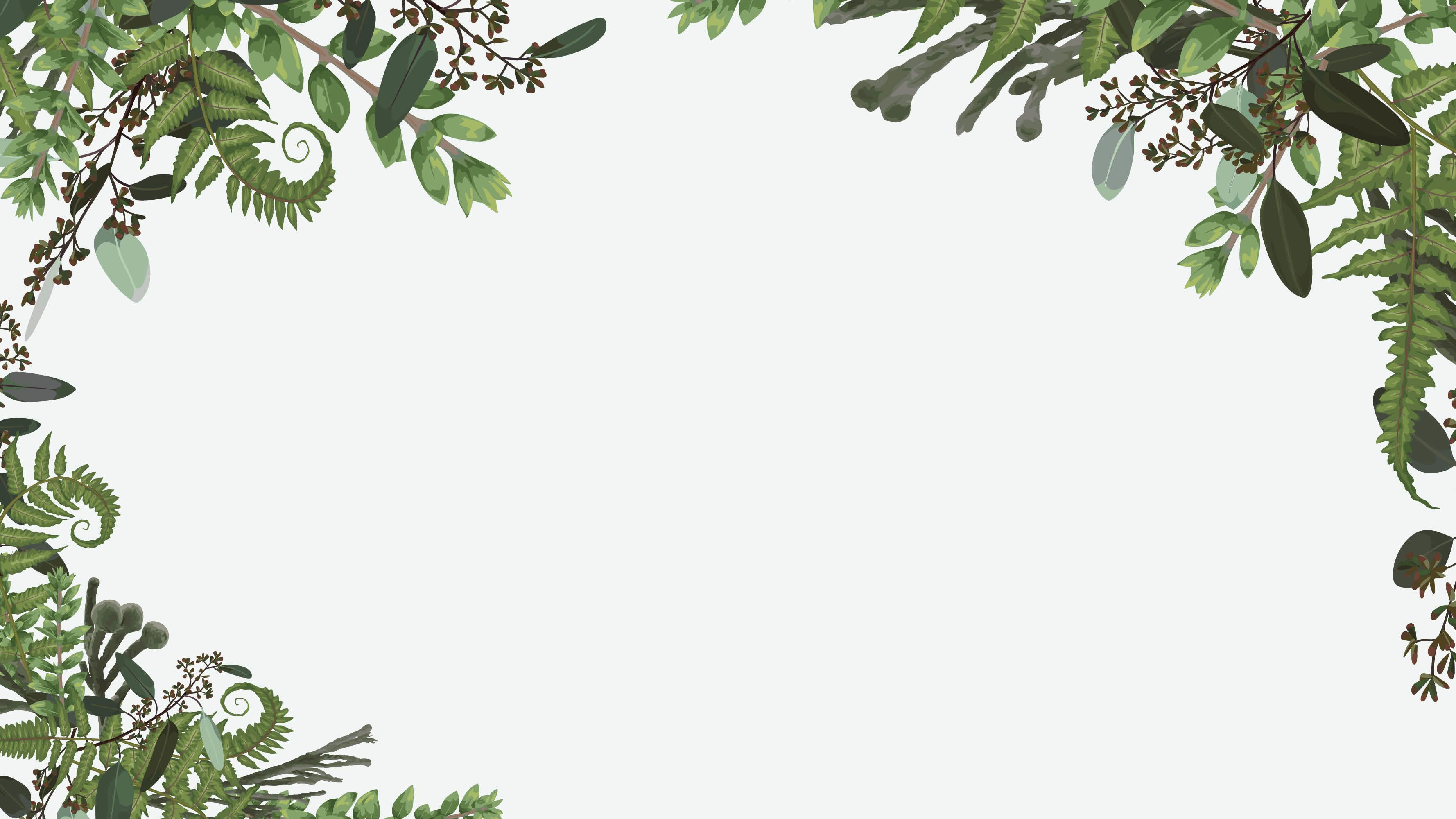
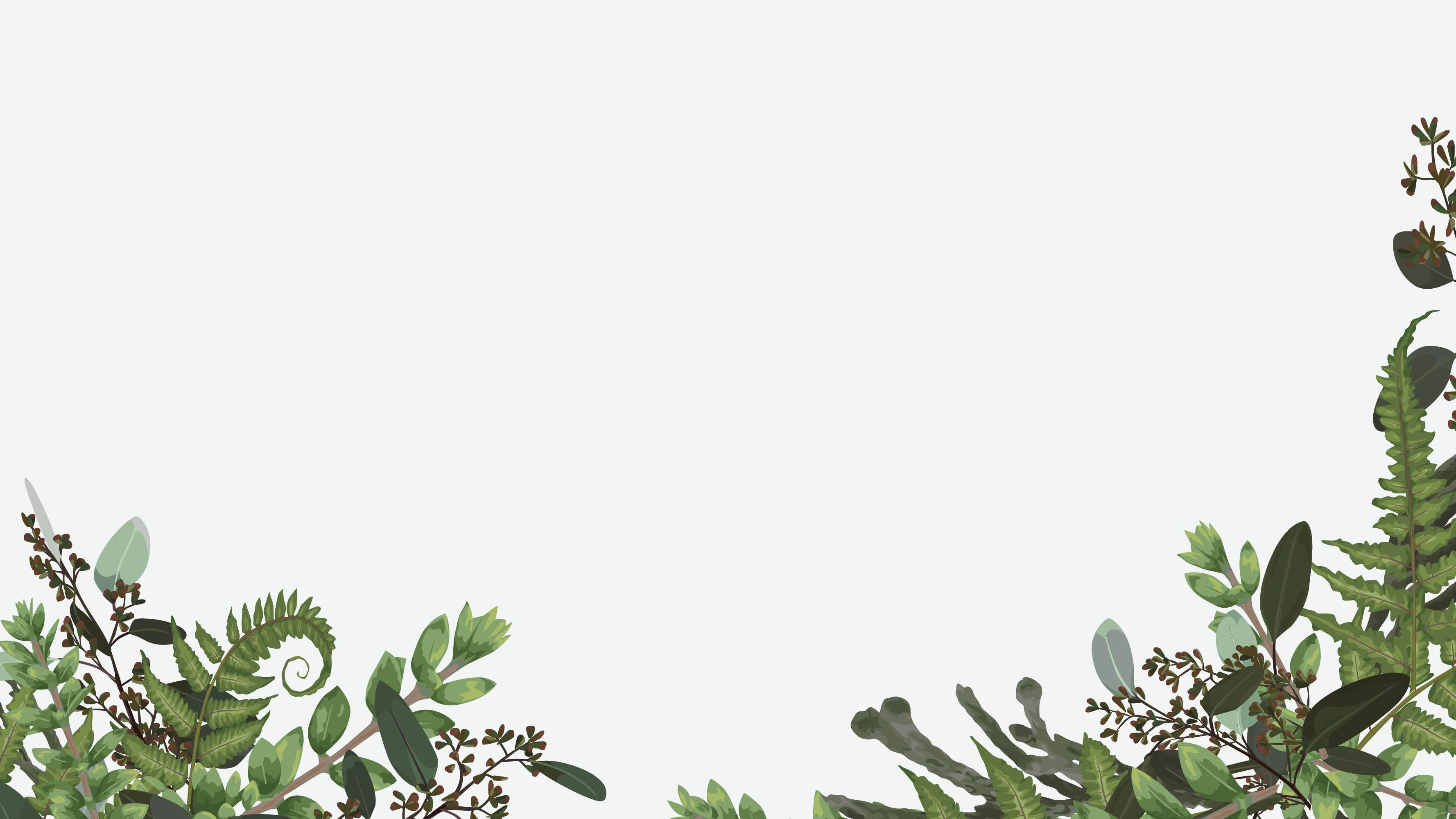
Want to know more?
Please visit Emory Magazine, Emory News Center, and Emory University.


